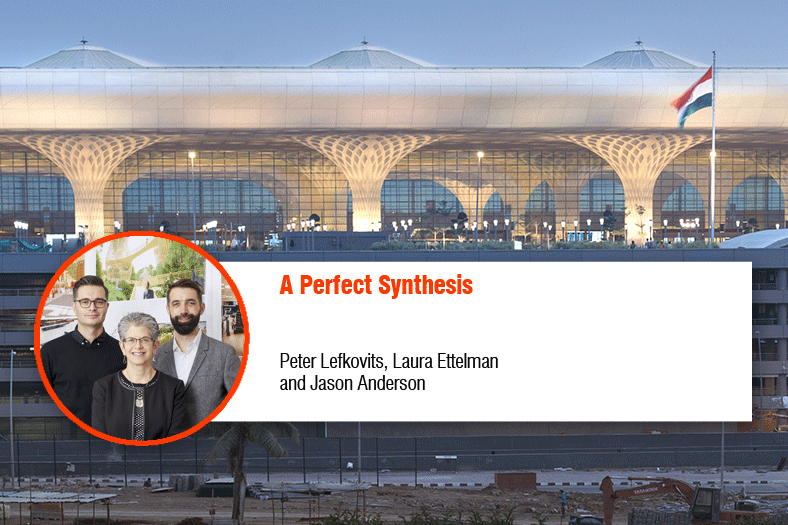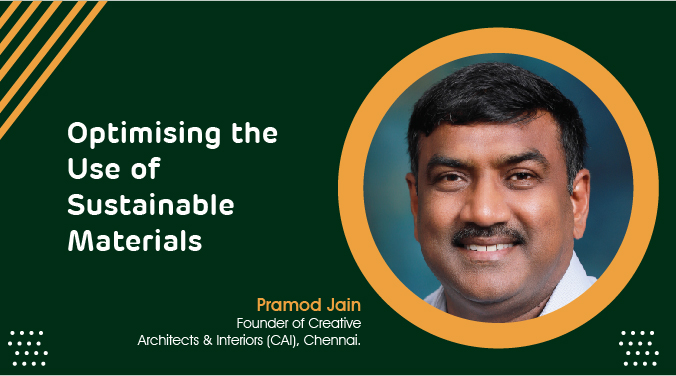A Perfect Synthesis

Responsible for creating some of the built environment marvels across the world, the projects designed by Skidmore, Owings & Merrill LLP (SOM) represent a perfect synthesis of planning, interiors, engineering and architecture. Vikas Bhadra catches up with Peter Lefkovits, Laura Ettelman and Jason Anderson; the three experts behind some of the successful projects SOM has executed in India and across the world.
SOM – As a teen who was surrounded by a good deal of friends pursuing engineering, it boiled down to “Strength of Materials”. Time went by and my affinity for the written word made me realise the other connotation of SOM, a connotation which implies, among other things, the magnificent universe of architecture and design.
Founded in 1936 in Chicago, Skidmore, Owings & Merill LLP (SOM) is responsible for the genesis of some of the most technically and environmentally advanced buildings and public spaces. From Beijing to Tel Aviv and New York to London, the footprints of SOM has etched it expertise on the Indian soil too. The T2 terminals of the Chatrapati Shivaji Mumbai International Airport and the Kempegowda International Airport in Bengaluru are some of the finest examples the firm has scripted in India, and then there is more.
Behind this seamless concoction of planning, interiors, engineering and architecture, is a team at work. A team, whose symbiosis brings to fruition the design ideas, from the drawing board to life.
Peter Lefkovits, AIA – Director at Skidmore, Owings & Merrill LLP (SOM)
What is your idea of good architecture and design? Is it static or dynamic?
Good design is born from an integrated approach. At SOM, we merge our expertise in architectural, structural, and environmental design to produce buildings that are both innovative and purposeful. The journey to achieving balance between human comfort and functionality, structure and program, and nature and technology is one that is inherently dynamic and results in a design process that strives for conceptual clarity.
How was your experience working on T2 projects in Mumbai and Bangalore?
The opportunity to work on these two important transportation infrastructure projects in India has been hugely rewarding. Both projects have pushed the boundaries of what airport design can be and overcome the challenges of executing technically rigorous buildings in their respective regions. Working with GVK MIAL to design Chhatrapati Shivaji International Airport Terminal 2 in Mumbai has deepened our understanding of the culture, people, and natural environment of India. This terminal could not be anywhere else in the world and incorporates elements, such as ephemeral colored light tracing through the check-in hall, that immediately immerse visitors in the atmosphere of the region.
The terminal’s connection to India is supported by our collaboration with designers Abu Jani and Sandeep Khosla, which has yielded contemporary installations inspired by traditional Indian art and textiles. Similarly, in partnership with BIAL, our design for Kempegowda International Airport Bengaluru Terminal 2 creates a lush and serene transit environment that pays homage to the city’s historic landscape. Passengers will be able to experience air travel in new ways by immersing themselves in the abundant greenery of the complex. The project has inspired us to think differently about future possibilities for aviation architecture and implement a more human-center approach to transportation design.
In the contemporary ecosystem, how can architecture contribute effectively in upholding principles of sustainability and the cultural values of the region?
Cultural resonance and environmental performance are cornerstones of SOM’s design philosophy. It is imperative that we as architects seek solutions that not only thoughtfully consider the cultural context of our work but also mitigate the effects of climate change in all aspects of our practice. We must question whether a building can truly be considered beautiful if it is not sustainable.
Laura Ettelman – AIA, Managing Partner at Skidmore, Owings & Merrill LLP (SOM)
How challenging is the integration of the architectural design and technical development with the engineering requirements, especially when the project is futuristic in nature?
Design thrives on challenge, universally. Project constraints or hurdles such as cutting-edge technologies, client requirements, and complicated programs as well as unique site and cultural conditions drive our work forward. They force us to rethink common assumptions, reconsider the solutions that we have turned to in past projects, and, ultimately, innovate and create something new. As an integrated practice, we at SOM approach our work as an intense collaboration between architecture, structural systems, and building systems that results in transformative solutions. These challenges are some of the reasons we love what we do.
From the drawing board to reality, having witnessed the intricacies involved in bringing architecture and design ideas to life, what according to you is the idea of good design?
Each project is a specific response to a particular place, context, client, and program. Designs that result from the synthesis of these considerations should be unique while balancing the requirements of each of these key inputs. This particularity is fundamental to good design; we have accomplished our aims when we arrive at a design that embodies the rigor of a project’s functional requirements, incorporates human-focused and environmental elements that delight users, and is unquestionably of its place.
Jason Anderson, AIA, Associate Director at Skidmore, Owings & Merrill LLP (SOM)
Having worked in India, what is your view on the Indian design sensibilities, how does it play out in the global design scheme?
The Indian design sensibility tends to be very forward-looking and global in its references, without becoming generic. For instance, in the course of my work in India, I have been struck by the degree to which our clients seek out designs that actively incorporate landscape and garden components. There is a very strong desire to embrace these elements not just as an exterior setting, but also as an integral feature of the architecture that bridges interior and exterior and becomes almost ubiquitous. This fondness of organic landscapes and greenery is reflective of larger global trends, to some extent, but the Indian aesthetic has taken it up with an enthusiasm that is unique and genuine. We see motifs emerging across various scales and typologies, and cropping up in different markets around the country with great frequency. My sense is that such elements strike a chord with some of the rich cultural traditions around gardens, which are a central part of Indian design. The melding of the contemporary and the traditional in this way can be really gratifying in its particularity.
What are some of the mixed-use projects SOM has executed in India? In your opinion, how does a mixed-use project make sense to cities which encompass a culturally and economically diverse population?
We have a few mixed-use projects on the boards at the moment, but much of our work in India tends to focus on single-use developments. However, mixed-use projects are increasingly gaining favor, which I think is a positive trend. Such complexes, in their most successful instances, can really help to extend and enrich the public sphere and to create spaces for exchange and discovery. A mixed-use project is not in and of itself going to resolve the tensions that arise in a dynamic, diverse society like that which characterizes the Indian city. But, when it is done right, it can create a platform that fosters familiarity and community.
Cookie Consent
We use cookies to personalize your experience. By continuing to visit this website you agree to our Terms & Conditions, Privacy Policy and Cookie Policy.









